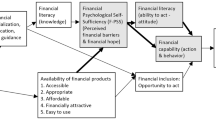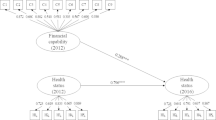Abstract
This study examined financial capability and economic hardship among low-income older Asian immigrants in a supported employment program (N = 142). Financial capability was defined as a combination of financial literacy, financial access, and financial functioning. Economic hardship was defined as the inability to meet basic needs. Results demonstrated that the majority of the sample had difficulty meeting basic needs. Most respondents answered basic financial knowledge questions incorrectly, and few applied prudent financial management skills. Results indicated that financial access and financial functioning were negatively associated with the risk of experiencing economic hardship, whereas financial literacy was not significantly associated. These findings call for active public policies and programs that address economic challenges among low-income Asian immigrants by enhancing their financial capability.

Similar content being viewed by others
References
Alley, D. E., Soldo, B. J., Pagán, J. A., McCabe, J., deBlois, M., Field, S. H., et al. (2009). Material resources and population health: Disadvantages in health care, housing, and food among adults over 50 years of age. American Journal of Public Health, 99(S3), S693–S701. doi:10.2105/AJPH.2009.161877.
Angel, R. J., Frisco, M., Angel, J. L., & Chiriboga, D. A. (2003). Financial strain and health among elderly Mexican-origin individuals. Journal of Health and Social Behavior, 44(4), 536–551. doi:10.2307/1519798.
Ashiabi, G. S., & O’Neal, K. K. (2007). Is household food Insecurity predictive of health status in early adolescence?: A structural analysis using the 2002 NSAF data set. Californian Journal of Health Promotion, 5(4), 76–91.
Asian Americans Advancing Justice. (2011). A community of contrasts: Asian Americans in the United States: 2011. Washington, DC: Asian Americans Advancing Justice.
Babiarz, P., & Robb, C. A. (2013). Financial literacy and emergency saving. Journal of Family and Economic Issues, Online First.,. doi:10.1007/s10834-013-9369-9.
Beck, T., Demirguc-Kunt, A., & Martinez Peria, M. S. (2007). Reaching out: Access to and use of banking services across countries. Journal of Financial Economics, 85(1), 234–266. doi:10.1016/j.jfineco.2006.07.002.
Beverly, S. G. (2001). Measures of material hardship: Rationale and recommendations. Journal of Poverty, 5(1), 23–41. doi:10.1300/J134v05n01_02.
Birkenmaier, J., & Huang, J. (2013). A new framework for financial capability: An extension of nussbaum’s capability approach. St. Louis, MO: Saint Louis University School of Social Work.
Borjas, G. J. (2009). Economic well-being of the elderly immigrant population. Cambridge, MA: National Bureau of Economic Research.
Burr, J. A., Gerst, K., Kwan, N., & Mutchler, J. E. (2008). Economic well-being and welfare program participation among older immigrants in the United States. Generations, 32(4), 53–60.
Choi, S. (2011). Longitudinal changes in access to health care by immigrant status among older adults: the importance of health insurance as a mediator. The Gerontologist, 51(2), 156–169. doi:10.1093/geront/gnq064.
Coleman-Jensen, A., Nord, M., Andrews, M., & Carlson, S. (2012). Household food security in the united states in 2011. Washington, DC: US Department of Agriculture, Economic Research Service.
Danziger, S., Corcoran, M., Danziger, S., & Heflin, C. M. (2000). Work, income, and material hardship after welfare reform. Journal of Consumer Affairs, 34(1), 6–30. doi:10.1111/j.1745-6606.2000.tb00081.x.
Federal Interagency Forum on Aging-Related Statistics. (2012). Older Americans 2012: Key indicators of well-being. Washington, DC: US Government Printing Office.
Gillen, M., & Kim, H. (2013). Older adults’ receipt of financial help: Does personality matter. Journal of Family and Economic Issues, Online First.,. doi:10.1007/s10834-013-9365-0.
Government Accountability Office. (2010). Consumer finance: Factors affecting the financial literacy of individuals with limited english proficiency. Washington, DC: Government Accountability Office.
Haron, S. A., Sharpe, D. L., Abdel-Ghany, M., & Masud, J. (2013). Moving up the savings hierarchy: Examining savings motives of older Malay muslim. Journal of Family and Economic Issues, 34(3), 314–328. doi:10.1007/s10834-012-9333-0.
He, W. (2002). The older foreign-born population in the United States: 2000. Washington, DC: US Government Prining Office.
He, W., Sengupta, M., Velkoff, V. A., & DeBarros, K. A. (2005). 65+ in the United States:2005. Washington, DC: US Census Bureau.
Heflin, C. M., Corcoran, M. E., & Siefert, K. A. (2007). Work trajectories, income changes, and food insufficiency in a Michigan welfare population. Social Service Review, 81(1), 3–25. doi:10.1086/511162.
Heflin, C., Sandberg, J., & Rafail, P. (2009). The structure of material hardship in US households: An examination of the coherence behind common measures of well-being. Social Problems, 56(4), 746–764. doi:10.1525/sp.2009.56.4.746.
Huang, J., Guo, B., & Kim, Y. (2010). Food insecurity and disability: Do economic resources matter? Social Science Research, 39(1), 111–124. doi:10.1016/j.ssresearch.2009.07.002.
Huang, J., Nam, Y., & Sherraden, M. S. (2013). Financial knowledge and Child Development Account policy: A test of financial capability. Journal of Consumer Affairs, 47(1), 1–26. doi:10.1111/joca.12000.
Huston, S. J. (2010). Measuring financial literacy. Journal of Consumer Affairs, 44(2), 296–316. doi:10.1111/j.1745-6606.2010.01170.x.
Joassart-Marcelli, P., & Stephens, P. (2010). Immigrant banking and financial exclusion in Greater Boston. Journal of Economic Geography, 10(6), 883–912. doi:10.1093/jeg/lbp052.
Kim, J., Chatterjee, S., & Cho, S. H. (2012). Asset ownership of new Asian immigrants in the United States. Journal of Family and Economic Issues, 33(2), 215–226. doi:10.1007/s10834-012-9317-0.
Kline, R. B. (2011). Principles and practice of structural equation modeling. New York: The Guilford Press.
Levy, H. (2009). Income, material hardship, and the use of public programs among the elderly. Ann Arbor, MI: Michigan Retirement Research Center, University of Michgan.
Lusardi, A., & Mitchell, O. S. (2006). Financial literacy and planning: Implications for retirement wellbeing. Hanover, NH: Dartmouth College, Department of Economics.
Lusardi, A., & Mitchell, O. S. (2007). Financial literacy and retirement planning: New evidence from the Rand American Life Panel. Ann Arbor, MI: Michigan Retirement Research Center, University of Michgan.
Muthén, B., Kaplan, D., & Hollis, M. (1987). On structural equation modeling with data that are not missing completely at random. Psychometrika, 52(3), 431–462. doi:10.1007/BF02294365.
Muthén, L., & Muthén, B. (2012). Mplus user’s guide. Los Angeles: Muthén and Muthén.
Nam, Y. (2008). Welfare reform and older immigrants’ health insurance coverage. American Journal of Public Health, 98(11), 2029–2034. doi:10.2105/AJPH.2007.120675.
Nam, Y., & Jung, H. J. (2008). Welfare reform and older immigrants: Food stamp program participation and food insecurity. The Gerontologist, 48(1), 42–50. doi:10.1093/geront/48.1.42.
Nam, Y., Lee, E. J., Huang, J., & Kim, J. (2013). Financial capability and asset ownership among low-income older Asian immigrants. Manuscript submitted for publication.
Newberger, R., Rhine, S., & Chiu, S. (2004). Immigrant financial market participation: Defining the research questions. Chicago Fed Letter, 199. Retrieved November 13, 2013, from http://www.chicagofed.org/digital_assets/publications/chicago_fed_letter/2004/cflfebruary2004_199.pdf.
Nussbaum, M. (1999). Women and human development: The capabilities approach. New York: Cambridge University Press.
Osili, U. O., & Paulson, A. (2006). Immigrant-native differences in financial market participation. Chicago: Federal Reserve Bank of Chicago.
Osili, U. O., & Paulson, A. L. (2008). Institutions and financial development: Evidence from international migrants in the United States. The Review of Economics and Statistics, 90(3), 498–517. doi:10.1162/rest.90.3.498.
Ouellette, T., Burstein, N., Long, D., & Beecroft, E. (2004). Measures of material hardship: Final report. Washington, DC: US Department of Health and Human Services, Office of the Assistant Secretary for Planning and Evaluation.
Parish, S. L., Rose, R. A., & Andrews, M. E. (2009). Income poverty and material hardship among US women with disabilities. Social Service Review, 83(1), 33–52. doi:10.1086/598755.
Parish, S. L., Rose, R. A., Grinstein-Weiss, M., Richman, E. L., & Andrews, M. E. (2008). Material hardship in US families raising children with disabilities. Exceptional Children, 75(1), 71–92.
Patraporn, R. V., Pfeiffer, D., & Ong, P. (2010). Building bridges to the middle class: The role of community-based organizations in Asian American wealth accumulation. Economic Development Quarterly, 24(3), 288–303. doi:10.1177/0891242410366441.
Paulson, A., Singer, A., Newberger, R., & Smith, J. (2006). Financial access for immigrants: Lessons from diverse perspectives. Chicago: Federal Reserve Bank of Chicago and the Brookings Institution.
Pew Research Center. (2012). The rise of Asian Americans. Washington, DC: Pew Research Center.
Phua, V., McNally, J. W., & Park, K. S. (2007). Poverty among elderly Asian Americans in the twenty-first century. Journal of poverty, 11(2), 73–92. doi:10.1300/J134v11n02_04.
Rhine, S. L., & Greene, W. H. (2006). The determinants of being unbanked for US immigrants. Journal of Consumer Affairs, 40(1), 21–40. doi:10.1111/j.1745-6606.2006.00044.x.
Sherraden, M. (2013). Building blocks of financial capability. In J. Birkenmaier, M. Sherraden, & J. Curley (Eds.), Financial capability and asset development: Research, education (pp. 1–73). New York and Oxford: Oxford University Press.
Tucker-Seeley, R. D., Li, Y., Subramanian, S. V., & Sorensen, G. (2009). Financial hardship and mortality among older adults using the 1996–2004 Health and Retirement Study. Annals of Epidemiology, 19(12), 850–857. doi:10.1016/j.annepidem.2009.08.003.
Walters, N. P., & Trevelyan, E. N. (2011). The newly arrived foreign-born population of the United States: 2010 American Community Survey briefs. Washington, DC: US Census Bureau.
Wan, H., Sengpta, M., Velkoff, V. A., & DeBarros, K. A. (2005). 65+ in the United States: 2005. Washington, DC: US Census Bureau.
Wong, R., Díaz, J. J., & Higgins, M. (2006). Health care use among elderly Mexicans in the United States and Mexico: The role of health insurance. Research on Aging, 28(3), 393–408. doi:10.1177/0164027505285922.
Wothke, W. (1998). Longitudinal and multi-group modeling with missing data. In T. D. Little, K. U. Schnabel, & J. B. Mahwah (Eds.), Modeling longitudinal and multiple group data: Practical issues, applied approaches and specific examples (pp. 197–216). Hillsdale, NJ: Lawrence Erlbaum Publishers.
Acknowledgments
This study was supported in part by Grants from the Les Brun Research Endowment Fund, Buffalo Center for Social Research, School of Social Work, University at Buffalo, and the Civic Engagement Research Dissemination Fellowship Program, University at Buffalo. We are thankful to Christine Takada, Miriam Suen, Helen Jang, Norman Lee, Junghee Han, Xiao-yu Yang, Kerry Situ, and Yong-Jin Ahn for their assistance for data collection. We are grateful to Ya-Ling Chen, Elizabeth Hole, Jun Pyo Kim, Amanda Brower, and Sarah Nesbitt for their research assistance and to Jennifer Gann for editing assistance.
Author information
Authors and Affiliations
Corresponding author
Electronic supplementary material
Below is the link to the electronic supplementary material.
Rights and permissions
About this article
Cite this article
Huang, J., Nam, Y. & Lee, E.J. Financial Capability and Economic Hardship Among Low-Income Older Asian Immigrants in a Supported Employment Program. J Fam Econ Iss 36, 239–250 (2015). https://doi.org/10.1007/s10834-014-9398-z
Published:
Issue Date:
DOI: https://doi.org/10.1007/s10834-014-9398-z




